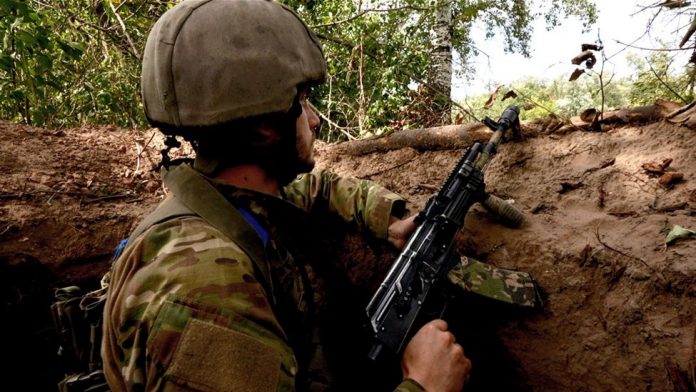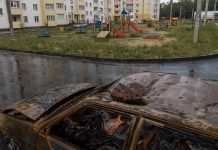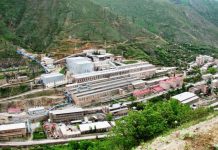Government forces in Ukraine are trying to seize the initiative from Russian troops before the arrival of winter. A counter-offensive is already under way in the south and the Ukrainians are now preparing to expand that in the east to take back land lost in Donbas and around Kharkiv in the north. Quentin Sommerville and camera-journalist Darren Conway have been given exclusive access to a unit of Ukrainian troops.
The air is thick with the smell of burning sunflowers, and the pat-pat-pat of Russian cluster bombs can be heard landing across the fields, setting fire to a crop which stands, heads bowed, awaiting a harvest that’s unlikely to come.
A self-propelled gun roars through the field, its caterpillar tracks tearing up the rich Donbas earth. The National Guard hold this ground in Ukraine’s east – territory that Vladimir Putin has claimed as central to his war aims. It will be taken “step-by-step”, he said. But for now, Russian progress has been reduced to a crawl.
And hanging heavy in the air, among the smoke and dust, is something else – expectation. Here in Donbas, and further north on the outskirts of Kharkiv, Ukraine’s second city, the country’s forces are braced for a counter-offensive.
I recently left army positions in the south, around Kherson. It is the only city that Russian forces have captured west of the strategically important Dnipro River. Those same troops are now engaged in battle, supporting forces who have broken through Russian lines in at least three places, as part of a long-planned counter-offensive in the south. Strict Ukrainian reporting restrictions are in place as the operation is under way.
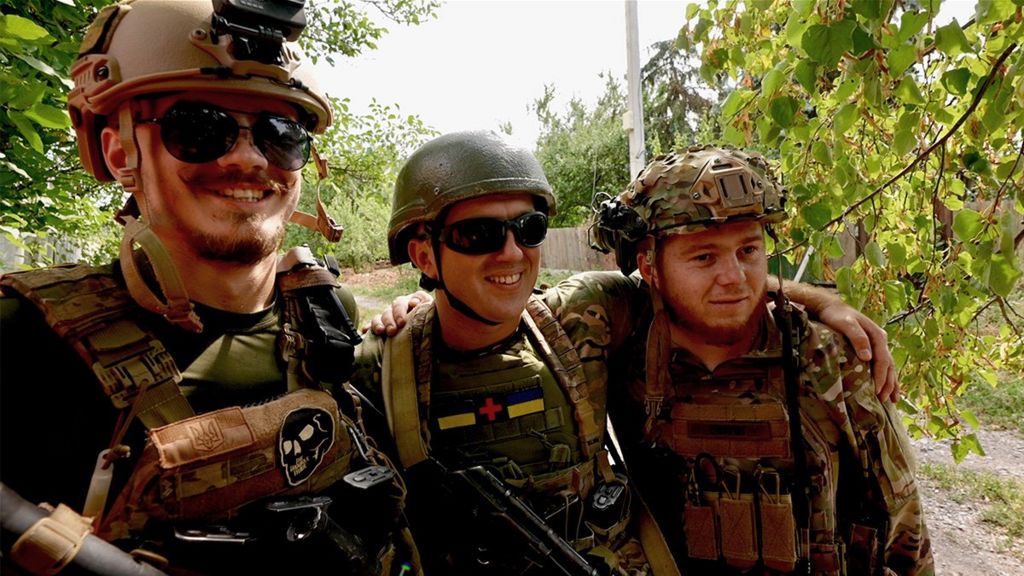
Here in Donbas, they remain tight-lipped. I’m not told the destination beforehand, and a unit press officer asks me not to name the regiment. He removes identifying patches from the men we film.
Amid the din of artillery fire in a base under the cover of trees, Artyom, 35, says we are north of the city of Siversk, some 8km (five miles) from the Russian front line. “How close do you get to them?” I ask. “Thirty metres,” he replies, “would you like to see?”
These are all defensive positions but the success around Kherson leads many to think that more offensives are planned here and further north.
I’m handed over to a red-haired guardsman who goes by the name of Svarog. He is 26 and baby-faced with a beard. “I’d look 18 without it,” he says with a grin. But after six months of fighting, he’s battle-hardened.
His unit saw its hardest fighting in July in nearby Lyschansk and Sivierodonetsk, where they were heavily outnumbered.
The fighting here is different. “They are not coming in such big numbers,” Svarog says. ”They no longer advance in battalion groups – they advance in a platoon, a detachment.” One unit commander had explained that in the field they have one man for every three of the enemy. In Sivierodontesk it was one to seven.
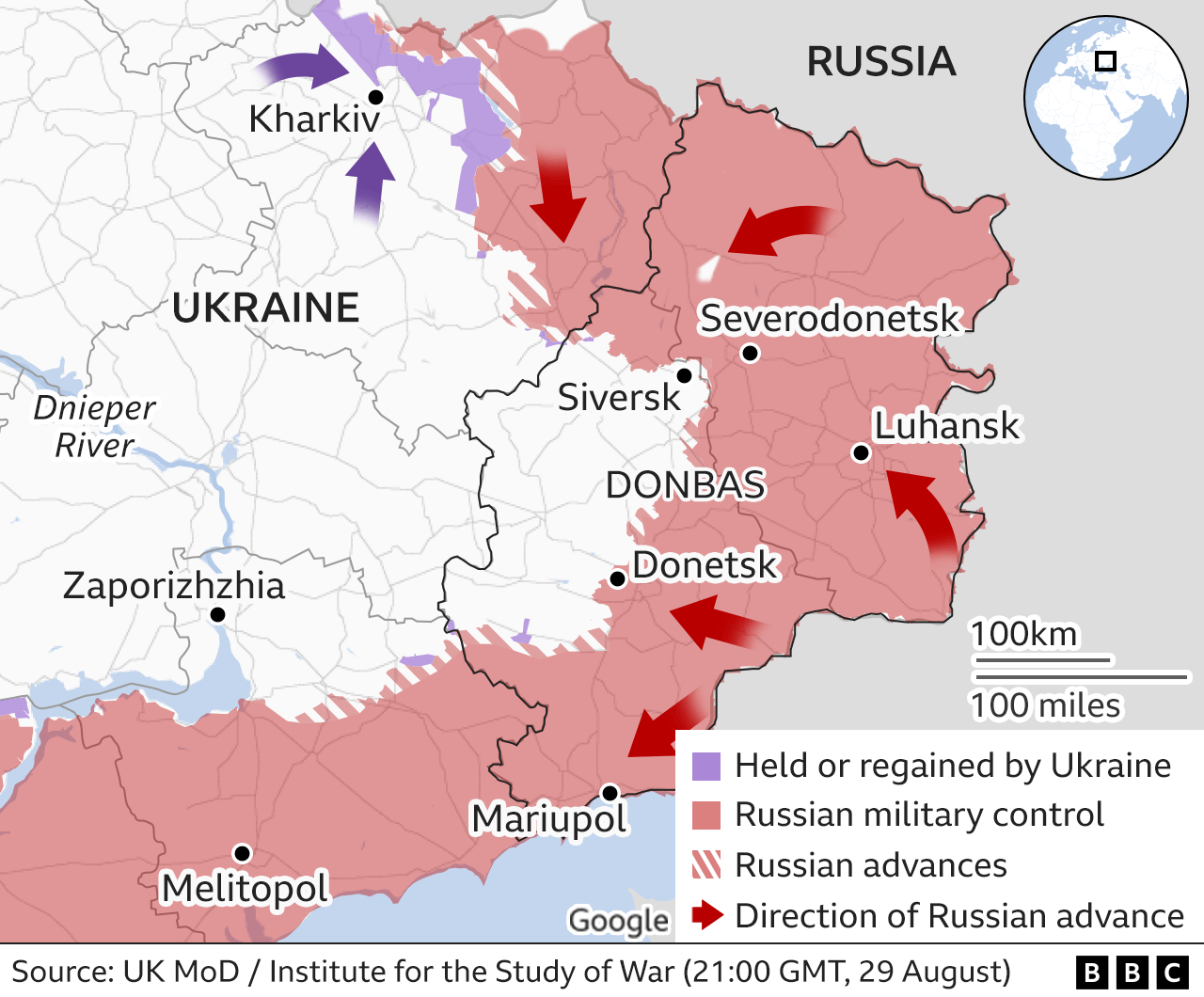
I’m taken on foot to the most forward position. The shelling is constant but at a distance. Instead there is a more immediate threat – anti-personnel mines. I count five as we walk along a muddy path to the river.
At the riverbank, we head into a network of trenches and I’m told to whisper. It is only an observation post but it is packed full of weaponry. “Where are the Russians?”, I ask a guardsman. He points to the opposite bank of the river, 30 or so metres away.
Nearby are craters, and a shell from a spent Russian rocket. This, first and foremost, is as an observation post, not a combat position, I’m told. “But if there is a threat that they are crossing over to our riverbank, then we will open fire,” the guardsman says.
In a nearby village that looks like so much of this part of Ukraine, broken apart by artillery, mostly abandoned by its residents, I meet Sergiy, 65, and his dog Mukha.
I ask the obvious question – why doesn’t he leave? “My parents lived and died in this house,” he replies. “I can’t go anywhere. I sent my wife away and live here on my own. Everything is okay, I have food and a small farm. The dog is not hungry.”
Sergiy says he’s proud to be Ukrainian. He’s not a “nationalist” but says he believes in Ukraine and the Armed Forces.

But others here are more ambivalent. Svarog’s unit say that a marked difference from when they fought around Kyiv is the divided loyalty of some of those they have met.
I walk with his men down another ruined village lane. They are, of course, armed and we are all wearing body armour and helmets. A gaggle of geese is almost enough to drown out the artillery duel taking place above our heads. We are invited into a courtyard, full of grape vines and roses, where a family go about their business as if war wasn’t raging around them.
Julia, 35-year-old nursery school teacher, laughs when I ask her about living under this threat. “Imagine that war came to you and you had to pack up and leave your home in 24 hours,” she asks. “You would, just like me, try to hang on to what you have spent your whole life making.”
Her sister Liliia stands nearby. It is her 19th birthday on the day I visit. On her wrist she has a tattoo – “dulcius ex asperis” it reads – Latin for “sweetness follows hardship”.
Their father berates the Ukrainian government for failing to negotiate. “They need to sit down at the negotiating table and come to an agreement. It’s not right to carry on like this,” he says.
Julia disagrees. Quietly she says: “We understand, and we believe that reason will prevail. We’ll wait a month, or two for the front line to even out and things will be good again here.”
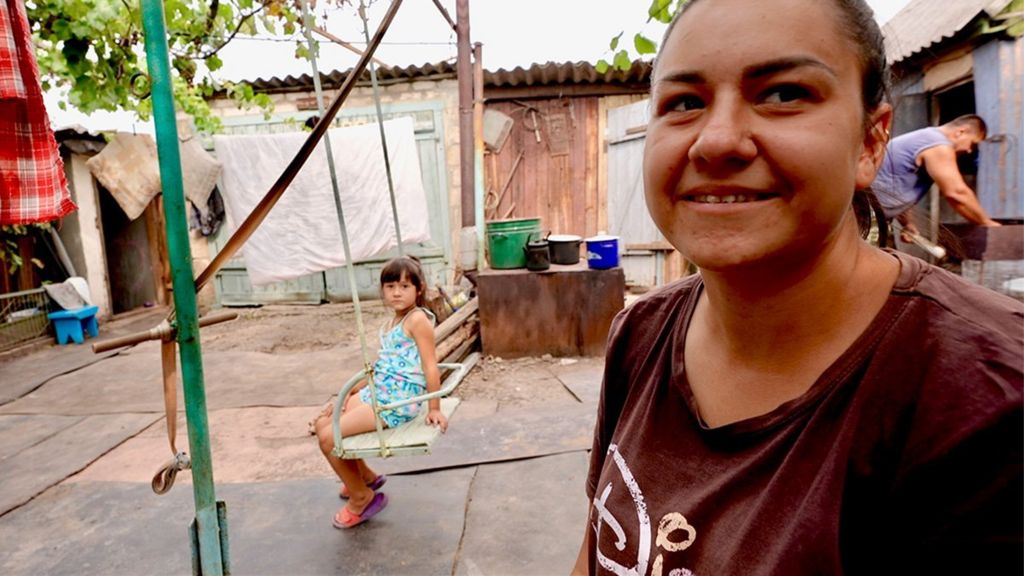
Days later, I travel south and meet Ruslan, a combat medic chief who, despite seeing the daily human catastrophe of this war, still fizzes and whirrs with good humour. When we arrange to meet him in a village not far from the front, I ask how I’ll spot him.
“Look for the fluffy ambulance, you won’t be able to miss it,” he says.
Sure enough, the vehicle arrived by the village bus stop covered in home-made camouflage netting, like a parade-float hedgehog. We follow him at speed to a frontline “stabilisation point”, where the injured soldiers receive immediate life-saving care.
The idiosyncrasies of combat medics are legendary. So it should be no surprise that when we arrive Yuri, the surgeon for Ruslan’s medics, is wearing nothing but camouflage shorts. He has in his hand a metal detector. “He’s looking for gold,” jokes Ruslan.
After a while, Yuri’s earphones whine and with a small army trowel, he produces a black lump of ore from the ground. “It’s just a hobby,” he says, sheepishly.
The clinic is piled high with supplies. “We want to say thank you to our foreign donors,” Ruslan says. “We haven’t unpacked yet. Sometimes we never have time to fully unpack.”
He takes me through a handwritten notebook of all the injuries they have treated over the past month. Time of arrival, name, type of injury. “The more writing on the page, the more difficult the case,” says Ruslan.
Some 9,000 Ukrainian soldiers have died since the start of the war, says Ukrainian commander-in-chief Gen Valerii Zaluzhnyi. Individual unit losses and injuries are a closely guarded secret. In Ruslan’s thick notebook there were fewer deaths than I had imagined. “We’ve come a long way since 2014,” he says, referring to rapid modernisation of Ukrainian forces, including combat medics.
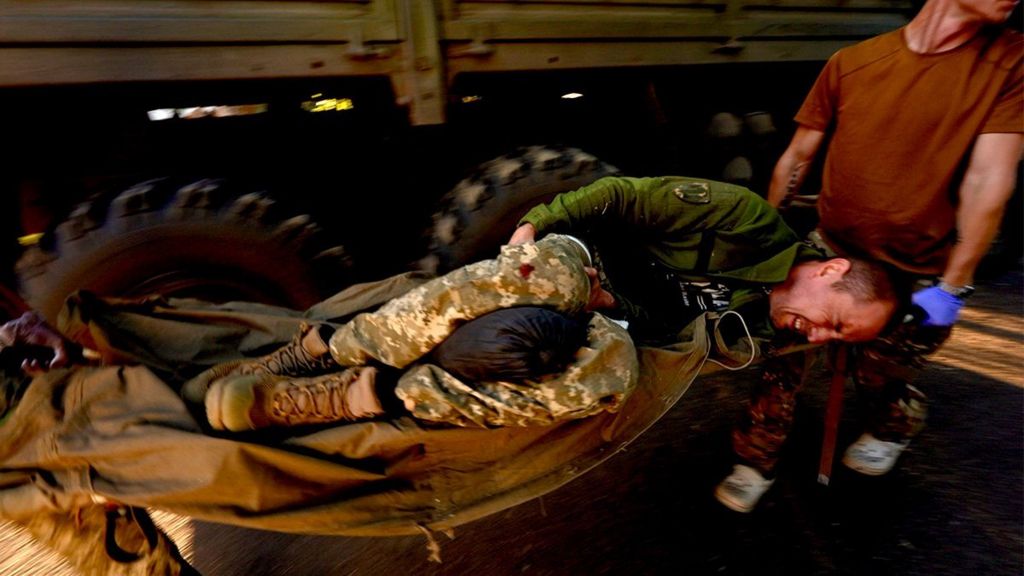
Ukrainian artillery is working all around us. A powerful M777 howitzer is firing nearby, and at night we hear a High Mobility Artillery Rocket System (HIMARS) firing its long-range munitions. These new weapons helped prepare the ground for the offensive in the south, and it is hoped they will do the same in the east.
I sit with Vlad, a slight 26-year-old who is now the unit’s ambulance driver. He was a ship’s engineer (second class) until the start of the war. His frigate, the Hetman Sahaidachny, was scuttled to stop it falling into Russian hands. Before getting behind the wheel of the ambulance he was an artillery man, and can name every boom and blast, as well as the year and make of tank and armour passing the clinic.
I ask him how he likes this duty compared to artillery. “There’s a lot of waiting around now,” he says.
But he doesn’t have to wait for long. A truck arrives suddenly at the clinic, with screams coming from the rear. The clinic operates on radio silence, the first they know of casualties is usually when they arrive at the door.
The first man is able to walk inside, but his right arm is hanging off, a gaping wound at his shoulder. The force of the explosion which detonated near him has broken his arm. A second man groans and shouts as he is lifted by Vlad and another medic on a stretcher into the clinic. He is covered in shrapnel wounds.
For the next 15 minutes, the emergency room is a scene of calm-but-determined activity. Yuri attends to the more seriously injured man on the stretcher, assisted by nursing staff. Senior Lt Viktor attends to the man with badly injured arm. The patients are quickly bandaged, and covered in silver heat blankets then sent for further treatment.
Yuri explains the next step. “We have up to an hour to quickly provide medical assistance before the patient goes to the hospital where a traumatologist, surgeon and trauma brigade take care of the patient”. Both will recover but the more seriously injured soldier is unlikely to return to duty. Ruslan sits down and adds anther two names to his notebook. These entries are short.
There would be four more injuries later that day, but in the meantime, Ruslan takes us to the trenches were casualties are first received.
Mortars begin landing at a tree-line, beyond where we stand. “It’s good that they didn’t hit the target, he laughs, now wearing full combat gear. That’s Russian precision for you.”
I ask him how they manage to retrieve casualties while under constant shelling. “No-one will endanger personnel. So, no matter how hard it sounds, you can’t lose strength and means, human resources, vehicles.
“When there’s a lull, or when the battle stops or the enemy is out of ammunition, that’s when the evacuation takes place immediately,” he says. “Until then, they try to save [casualties] on the spot with all the means they have. We’ve already lost too many combat medics.”
As we leave the front, the skies darken and lightning appears on the horizon. Bad weather is on its way, summer is ending and fighting conditions will worsen. The deep snows of winter will arrive threatening to freeze battle lines in place.
But for now, there is something else in the air here, an expectation that after months of stalemate, Ukraine could be about to again strike back.

